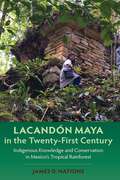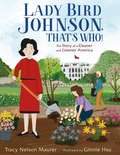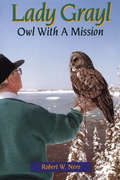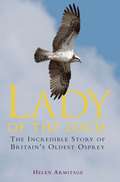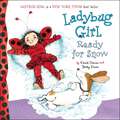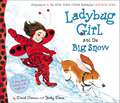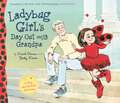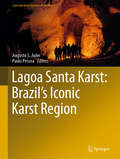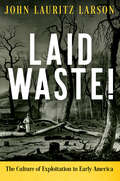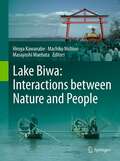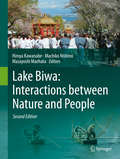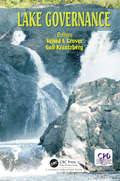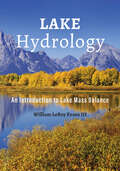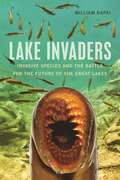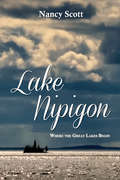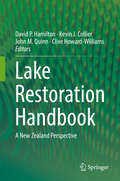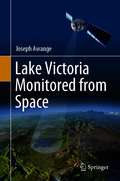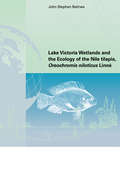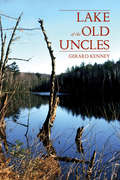- Table View
- List View
Lacandón Maya in the Twenty-First Century: Indigenous Knowledge and Conservation in Mexico's Tropical Rainforest (Maya Studies)
by James D. NationsFrom the ancient traditions of the Lacandón Maya comes an Indigenous model for a sustainable future Having lived for centuries isolated within Mexico’s largest remaining tropical rainforest, the Indigenous Lacandón Maya now live at the nexus of two worlds—ancient and modern. While previous research has focused on documenting Lacandón oral traditions and religious practices in order to preserve them, this book tells the story of how Lacandón families have adapted to the contemporary world while applying their ancestral knowledge to create an ecologically sustainable future. Drawing on his 49 years of studying and learning from the Lacandón Maya, James Nations discusses how in the midst of external pressures such as technological changes, missionary influences, and logging ventures, Lacandón communities are building an economic system of agroforestry and ecotourism that produces income for their families while protecting biodiversity and cultural resources. Nations describes methods they use to plant and harvest without harming the forest, illustrating that despite drastic changes in lifestyle, respect for the environment continues to connect Lacandón families across generations. By helping with these tasks and inheriting the fables and myths that reinforce this worldview, Lacandón children continue to learn about the plants, animals, and spiritual deities that coexist in their land. Indigenous peoples such as the Lacandón Maya control one-third of the intact forest landscapes left on Earth, and Indigenous knowledge and practices are increasingly recognized as key elements in the survival of the planet’s biological diversity. The story of the Lacandón Maya serves as a model for Indigenous-controlled environmental conservation, and it will inform anyone interested in supporting sustainable Indigenous futures. A volume in the series Maya Studies, edited by Diane Z. Chase and Arlen F. Chase
Lady Bird Johnson, That's Who!: The Story of a Cleaner and Greener America
by Tracy Nelson MaurerLady Bird Johnson, That's Who! is Tracy Nelson Maurer's lively picture book biography of Lady Bird Johnson, with a focus on her environmentalist passion and legacy as First Lady.Who fought to stop pollution? Who helped make America cleaner and greener? Lady Bird Johnson, That's Who!Claudia Alta Taylor was a lonely girl, shy as a butterfly growing up in Texas. She never dreamed she'd blossom into a visionary leader whose love for wildflowers, beautiful landscapes, and building community compelled her to lead the effort to combat pollution in the United States. A lifelong environmentalist, Lady Bird Johnson embraced her platform as First Lady to promote policy that beautified America’s roadways, waterways and parks, inspiring people to take pride in the places they live.With elements of women’s history, civics, and conservationism, this is a timely and informative picture book biography.
Lady Grayl: Owl With a Mission
by Robert W. Nero"This is the story of a man and his owl. But what a man and what an owl! The owl is one of our planet’s most beautiful and elusive beings, an enchanting spook, a feathered spirit from some ancient world. "The man is Robert Nero, his name synonymous with that of the Great Gray Owl, his love affair with the species spanning twenty-five years. For me, a non-professional adrift in a sea of biologists, it is heartening to find in Dr. Nero not just the able scientific mind but also a sense of wonder, undiminished by the years. Perhaps it is the mortality of all living things that makes them exquisite to him, for he writes of their brief beauty in poetry and prose. His words remind us of joys we once knew, of worlds to which we have grown blind. "What a privilege it is to share a time on Earth with a man like this, and to call him friend." - Katherine McKeever, The Owl Foundation, Vineland, 1994 "Bob Nero, one of Canada’s finest nature writers, has done it again! His fifth book, about Lady Grayl, is a personal account, something close to a love story. For nine years, since the rescue of a starving runt owlet from a wild brood, he has taken his beautiful owl, Lady Grayl, to countless schools and public meetings to preach the gospel of conservation. She and Bob are well-known throughout Manitoba, and beyond. "Bob’s careful observations of this imprinted owl supplement his 25 years of research into Great Gray Owls in the wild. Six sensitive poems and numerous photographs depict the owl in many moods and settings. This book will rank along with Bernd Heinrich’s acclaimed One Man’s Owl, which dealt with an imprinted Great Horned Owl, and will be of special interest to all who have been fortunate enough to see Lady Grayl." - C. Stuart Houston, University of Saskatchewan
Lady of the Loch: The Incredible Story Of Britain's Oldest Osprey
by Helen ArmitageDuring the last decade, the osprey has risen, phoenix-like, from the ashes - once extinct in Britain, now returned as a powerful symbol of hope. The opreys' story is a moving tale of triumph over adversity. Their slow but sure resurgence has attracted huge public interest and support; that of one bird in particular, Lady, at 25, Britain's oldest breeding osprey, has tugged at the world's heartstrings.For the past twenty years, Lady has made the 3000-mile journey from Africa back to Scotland, her nest and her mate. In March 2010, she produced an egg for a record-breaking 20th year; despite her weakened state throughout that summer, and with the stalwart assistance of her youthful mate, the chicks fledged successfully. But how many more times can Lady defy the odds; will the spring see her return, as, happily, it will so many other ospreys?
Lady of the Loch: The Incredible Story of Britain's Oldest Osprey
by Helen ArmitageDuring the last decade, the osprey has risen, phoenix-like, from the ashes - once extinct in Britain, now returned as a powerful symbol of hope. The opreys' story is a moving tale of triumph over adversity. Their slow but sure resurgence has attracted huge public interest and support; that of one bird in particular, Lady, at 25, Britain's oldest breeding osprey, has tugged at the world's heartstrings.For the past twenty years, Lady has made the 3000-mile journey from Africa back to Scotland, her nest and her mate. In March 2010, she produced an egg for a record-breaking 20th year; despite her weakened state throughout that summer, and with the stalwart assistance of her youthful mate, the chicks fledged successfully. But how many more times can Lady defy the odds; will the spring see her return, as, happily, it will so many other ospreys?
Ladybug Girl Ready for Snow (Ladybug Girl)
by Jacky DavisGetting dressed for a snow day is fun in this board book from the creators of The New York Times bestselling Ladybug Girl series It&’s snowing outside! First Bingo the dog helps Ladybug Girl get dressed in her warm clothes: snowpants, jacket, mittens, ear muffs, boots, wings, antennae, and tutu. Then the friends go out and decide to build a snow animal. What will they make? A snow Bingo, of course! A charming story simply told for the youngest Ladybug Girl fans.
Ladybug Girl and Bingo
by Jacky DavisLulu and Bingo are best friends! Whenever they play outside, Bingo always stays close by Lulu's side. When they go camping for the very first time, Lulu does her best to be responsible, and hold on tight to Bingo's leash. But what happens when Bingo wants to explore the forest on his own and runs off? This is a job for Ladybug girl! Picture descriptions present.
Ladybug Girl and the Big Snow (Ladybug Girl)
by Jacky DavisIn this hardcover picture book from the New York Times bestselling Ladybug Girl series, Ladybug Girl and Bingo need to look on the bright side of things to make their snow day adventure as much fun as it should be. Lulu and her dog Bingo wake up to a snow-covered yard and decide to have the best snow day ever. They make penguin tracks and taste the frosting-like snow. But the snow is deep and cold, and when Lulu tries to build a fort or make a snowball, her mittens are too wet and snow falls down the back of her neck. This is not the day she planned. And then Lulu remembers that she is Ladybug Girl and Ladybug Girl can do anything! With another determined look at the snow, Ladybug Girl overcomes her frustration and sees the yard in a whole new light. She and Bingo are now ready to use their imaginations to create their own snow games, snow animals, and snow adventures! For fans of The Snowy Day by Ezra Jack Keats, Ladybug Girl and the Big Snow honors the magic of the outdoors and creativity!
Ladybug Girl at the Beach (Ladybug Girl)
by Jacky DavisIt is preschooler Lulu’s first time at the beach and she needs to conquer her fear of the ocean in this hardcover picture book from the New York Times bestselling Ladybug Girl series. Lulu has never been to the beach but she knows she is going to love it…until she sees just how big and loud the ocean is. She and her dog Bingo decide that they will make sandcastles, fly kites, and get ice cream instead of swimming. But then the ocean waves snatch Lulu’s favorite pail. This is a job for Ladybug Girl! When Lulu is Ladybug Girl, she is brave and nothing can stop her from rescuing her pail – and suddenly she is in the ocean and it is fun! This story is the perfect preparation for a first beach vacation, or to explore a new experience with a preschooler. Mama and Papa are never far away while Ladybug Girl builds up her courage and confronts something scary for the first time. For fans of Fancy Nancy and Angelina Ballerina, the Ladybug Girl series honors courage, creativity, and a love of nature!
Ladybug Girl's Day Out with Grandpa (Ladybug Girl)
by Jacky DavisLadybug Girl and Grandpa visit the museum in the New York Times bestselling series&’ latest picture book! Lulu wants to learn everything, but she discovers that sometimes you have to slow down to appreciate the wonder of what's around you. When Lulu and Grandpa visit the museum, Lulu wants to see it all! Grandpa suggests exploring bit by bit, but Lulu can do it all—she&’s Ladybug Girl! But there is so much to see. Even Ladybug Girl may never see it all. Then Grandpa shows her something extra special: the butterfly room! Inside, Lulu slows down. She looks and listens. And she realizes that Ladybug Girl can be like a flower if she holds very still and thinks flower thoughts. When a shining blue butterfly lands on her finger, she understands that even if she can't learn everything in one day, she can learn so much from each moment, if she only takes the time to look around.
Ladybugs
by Gail GibbonsEverything you ever wanted to know about ladybugs— and why they're crucial to our environment. When you think of a ladybug, you might picture a little red beetle with seven black spots on its back—but did you know there are thousands of types of ladybugs, spread across the world? With her signature combination of simple text, clear illustrations, and simple diagrams, Gail Gibbons explores the world of ladybugs. These small beetles live on six of the seven continents, ranging in size, markings, and coloration. Follow a ladybug through the four stages of its development from egg to adult, and learn about its behavior and habitat—plus, how little ladybugs help protect crops by eating harmful insects. Bright illustrations and an easy-to-read text make this ideal for young readers studying the natural world. A page of quick ladybug facts and resources for learning more are included.
Lagoa Santa Karst: Brazil's Iconic Karst Region (Cave and Karst Systems of the World)
by Augusto S. Auler Paulo PessoaThis book discusses the Lagoa Santa Karst, which has been internationally known since the pioneering studies of the Danish naturalist Peter Lund in the early 1800s. It covers the speleogenesis, geology, vegetation, fauna, hydrogeology, geomorphology, and anthropogenic use of the Lagoa Santa Karst and is the first English-language book on this major karst area. The area, which has been at the heart of the debate on the origin and age of human colonization in the Americas, is characterized by a classical and scenic karst landscape with limestone cliffs, karst lakes and karst plains, in addition to numerous solution dolines. More than 1,000 caves have been documented in the area, many with significant archeological and paleontological value. Despite its great importance, the Lagoa Santa Karst faces severe environmental threats due to limestone mining and the expansion of the metropolis of Belo Horizonte and its surrounding towns. The growing recognition of the area’s remarkable significance has led to increasing concern, and a number of protected areas have now been established, improving the conservation status of this landmark karst area.
Laid Waste!: The Culture of Exploitation in Early America (Early American Studies)
by John Lauritz LarsonAfter humble beginnings as faltering British colonies, the United States acquired astonishing wealth and power as the result of what we now refer to as modernization. Originating in England and Western Europe, transplanted to the Americas, then copied around the world in the nineteenth and twentieth centuries, this process locked together science and technology, political democracy, economic freedom, and competitive capitalism. This has produced for some populations unimagined wealth and material comfort, yet it has also now brought the global environment to a tipping point beyond which life as we know it may not be sustainable. How did we come to endanger the very future of life on earth in our heedless pursuit of wealth and happiness?In Laid Waste!, John Lauritz Larson answers that question with a 350-year review of the roots of an American "culture of exploitation" that has left us free, rich, and without an honest sense of how this crisis came to be. Larson undertakes an ambitious historical synthesis, seeking to illuminate how the culture of exploitation grew out of the earliest English settlements and has continually undergirded U.S. society and its cherished myths. Through a series of meditations on key concepts, the story moves from the starving times of early Jamestown through the rise of colonial prosperity, the liberation of the revolutionary generation, the launching of the American republic, and the emergence of a new global industrial power by the end of the nineteenth century. Through this story, the book explores the rise of an American sense of righteousness, entitlement, and destiny that has masked any recognition that our wealth and success has come at expense to anyone or anything. Part polemic, part jeremiad, and part historical overview, Laid Waste! is a provocative and bracing account of how the development of American culture itself has led us to today's crises.
Lake Biwa: Interactions between Nature and People
by Hiroya Kawanabe Machiko Nishino Masayoshi MaehataThis book focuses on the long-term interactions between people and nature in and around Lake Biwa, one of the oldest lakes in the world. Accordingly, it not only covers the characteristics of the biota of this ancient lake, but also approaches it as a 'cultural ancient lake.' Furthermore, various problems affecting the lake, especially recent environmental changes that occurred before and after Japan's rapid economic growth of the 1950s and 60s, are reviewed, including water pollution, lakeshore development and the reclamation of attached lakes, alien and invasive species, and problems related to the recent warming of the climate. Lastly, by analyzing data on these problems collected by the local government and residents of the lake basin, the book provides a comprehensive outlook on the future of Lake Biwa and people's lifestyles. As such, it provides indispensable information for all people engaged in improving and conserving water regimes around the world, as well as people interested in the culture and history of Japan.
Lake Biwa: Second Edition
by Hiroya Kawanabe Machiko Nishino Masayoshi MaehataAlthough, the first edition had a similar focus, more than five years have passed since its publication and the biological and social circumstances of the lake have drastically changed due to, for example, the further expansion of alien species, the decrease of indigenous species, the progress of integrated watershed management by the Union of the Kansai Government which was established in 2010, the legislation of the Conservation and Restoration Act of Lake Biwa in 2015 and more. The new edition will therefore feature updated and new information on the above and more topics as well as updated and revised data based on the latest research. Inventories of respective taxa, especially those of small animals, are also revised based on the latest studies. Furthermore, this volume covers the characteristics of the biota of this ancient lake, but at the same time, it will also approach it as a ‘culture ancient lake’. Other topics also include water pollution, lakeshore development, the effects of global warming in the past and present, the influence of people, and countermeasures by local and national governments. Moreover, the volume also provides a comprehensive view on the future of Lake Biwa and that of its residents. Miraculously enough, this ancient lake has kept its water quality clear even until today despite the fact of more than 1.4 million people living on its shores. Finally, the book also gives indispensable information to those engaged in improving and conserving water regimes of lakes and other water bodies all over the world and to those interested in the culture and history of Japan. Lake Biwa is not only one of the rarest ancient lakes of the world, but the people’s involvement with the lake also goes back a long way. This is shown in the diverse culture developed in this area and in the various archaeological finds that date back as early as the Jomon Period, nearly 10.000 years ago. Today Lake Biwa fulfills an important role as a water resource by providing domestic, commercial, industrial, and agricultural water for over 14 million residents living around the Lake Biwa-Yodo River drainage basin. This updated volume focuses on the geological and biological features of the lake as well as on the long-term interactions between the people and the lake.
Lake Erie Stories: Struggle and Survival on a Freshwater Ocean
by Chad FraserMost people think of Lake Erie, the shallowest and second smallest of the Great Lakes, as a sun-drenched, nearly tropical retreat. But it is so much more; mysterious, unpredictable, and known by mariners for its sudden violent weather and dangerous shoals, Lake Erie has been the stage for some of the most dramatic events ever to occur on the North American continent. From the earliest explorations of First Nations and French adventurers to the brazen rumrunners of the Prohibition era and beyond, this fascinating book takes the reader inside the remarkable personalities and harrowing events that have shaped the lake and the towns and cities that surround it. Based on thorough research, extensive travels, and firsthand accounts from the people who have lived, worked and made their names on the lake, Lake Erie Stories takes a fresh look at the history of what may be the most colourful of all the Great Lakes.
Lake Governance: Lessons In Participatory Governance
by Velma I. Grover Gail KrantzbergThe Lake Governance book will focus on comparative analysis of governance structures by examining policy, legal and institutional structures of current transboundary commissions to develop a common framework for good governance of transboundary lakes. Cooperation among nations sharing natural resources is important for sustainable use of the shared resources. Lakes contribute a big part to GDP in most of the countries and in some cases are also responsible for providing fisheries (for food, source of protein and livelihood). Climate change and associated risks and uncertainties add more complexity to the problems. This book will explore current water governance challenges, knowledge gaps and recommend a framework for good lake governance.
Lake Huron Rock Picker's Guide
by Bruce Mueller Kevin GauthierBruce Mueller is owner of the C&M Rock Shop in Honor, Michigan. He holds a master's degree in geology from the University of Illinois. He is also the author of The Complete Guide to Petoskey Stones. Kevin Gauthier is a business graduate from Michigan State University and has completed courses through Gem Institute of America (GIA). He has spent a lifetime collecting, cutting, and polishing the gems found around Lake Huron. Kevin is co-author with Bruce Mueller of Lake Michigan Rock Picker's Guide and Lake Superior Rock Picker's Guide. He is owner of Korner Gem in Traverse City, Michigan: www. kornergem.com.
Lake Hydrology: An Introduction to Lake Mass Balance
by William LeRoy Evans IIIThe first book dedicated to describing the hydrology of water flow in lake systems, geared for limnologists and students of hydrology.With fresh water becoming a critical issue around the world, lake mass balance—the hydrology or water movement in lakes—is increasingly important to environmental studies and remediation projects. Unfortunately, lake hydrology is often only briefly covered in broader texts on hydrogeology and hydrology or is confined to specialized research papers. Lake Hydrology rigorously describes the hydrology of flow into and out of lake systems. Explaining the physical parameters that influence lake behavior, as well as the mathematics that describes these systems, this in-depth book fills an important niche in the literature of watershed science. This text• describes the physical structure and nature of drainage basins and explains the origin and classification of lakes• explores the hydrology of lake mass balance and storage as it pertains to lake stage, groundwater and lake bottom interaction, hypsometry, lake hydraulics, precipitation, surface flow, evaporation, and transpiration• provides models, practical information, and solutions for lake management or remediation planning utilizing basic data, including stage fluctuation, evapotranspiration, lake-bottom seepage, precipitation, and surface flow • uses examples from real-world long-term studies, including Utah's Great Salt Lake and Florida's Lake Jackson, a karstic lake system• examines the effect of storm events including the temporal and areal distribution of rainfall, and flow paths of water in the catchment from precipitation• includes an introduction to relevant scientific principles, such as dimensional analysis, the properties of water, and the hydrologic cycleUnlike most limnology texts, which emphasize lake ecology and biology, Lake Hydrology is designed to truly elucidate the hydrology of lake systems, especially as it relates to components of the hydrologic cycle. This book will greatly benefit professionals and researchers involved in lake management, remediation, or investigation of lake systems, and can be used as is or integrated within graduate and advanced undergraduate courses in limnology.
Lake Invaders: Invasive Species and the Battle for the Future of the Great Lakes (Great Lakes Books Series)
by William RapaiThere are more than 180 exotic species in the Great Lakes. Some, such as green algae, the Asian tapeworm, and the suckermouth minnow, have had little or no impact so far. But a handful of others--sea lamprey, alewife, round goby, quagga mussel, zebra mussel, Eurasian watermilfoil, spiny water flea, and rusty crayfish--have conducted an all-out assault on the Great Lakes and are winning the battle. In Lake Invaders: Invasive Species and the Battle for the Future of the Great Lakes, William Rapai focuses on the impact of these invasives. Chapters delve into the ecological and economic damage that has occurred and is still occurring and explore educational efforts and policies designed to prevent new introductions into the Great Lakes. Rapai begins with a brief biological and geological history of the Great Lakes. He then examines the history of the Great Lakes from a human dimension, with the construction of the Erie Canal and Welland Canal, opening the doors to an ecosystem that had previously been isolated. The seven chapters that follow each feature a different invasive species, with information about its arrival and impact, including a larger story of ballast water, control efforts, and a forward-thinking shift to prevention. Rapai includes the perspectives of the many scientists, activists, politicians, commercial fishermen, educators, and boaters he interviewed in the course of his research. The final chapter focuses on the stories of the largely unnoticed and unrecognized advocates who have committed themselves to slowing, stopping, and reversing the invasion and keeping the lakes resilient enough to absorb the inevitable attacks to come. Rapai makes a strong case for what is at stake with the growing number of invasive species in the lakes. He examines new policies and the tradeoffs that must be weighed, and ends with an inspired call for action. Although this volume tackles complex ecological, economical, and political issues, it does so in a balanced, lively, and very accessible way. Those interested in the history and future of the Great Lakes region, invasive species, environmental policy making, and ecology will enjoy this informative and thought-provoking volume.
Lake Nipigon: Where the Great Lakes Begin
by Nancy Scott2017 Gertrude H. Dyke Award — Nominated The history of Lake Nipigon, where the Great Lakes begin. The name Nipigon is evocative of storied brook trout, cold clear waters, elusive woodland caribou, sweeping vistas, and spectacular scenery. Situated in the heart of Northwestern Ontario, almost every map of North America shows Lake Nipigon as a significant geographic feature, yet few people know its story. As the primary watershed that flows into Lake Superior, Nipigon is the headwaters of the Great Lakes. This, the first inclusive historical account of Lake Nipigon, provides a fascinating overview of its extensive natural history, including information on species at risk, and interprets the story of human incursion into the area, from its aboriginal prehistory to the colourful fur trade, the harvesting of resources, the coming of the railway, recreational fishing, eventual settlement, and the communities that remain today.
Lake Restoration Handbook: A New Zealand Perspective
by David P. Hamilton Kevin J. Collier John M. Quinn Clive Howard-WilliamsLakes across the globe require help. The Lake Restoration Handbook: A New Zealand Perspective addresses this need through a series of chapters that draw on recent advances in modelling and monitoring tools, citizen science and First Peoples’ roles, catchment and lake-focused restoration techniques, and policy implementation. New Zealand lakes, like lakes across the globe, are subject to multiple pressures that have increased in severity and scale as land use has intensified, invasive species have spread and global climate change becomes manifest. This books builds on the popular Lake Managers Handbook (1987), which provided guidance on undertaking investigations into, and understanding lake ecosystems in New Zealand. The Lake Restoration Handbook: A New Zealand Perspective synthesises contemporary issues related to lake restoration and rehabilitation, integrated with social science and cultural viewpoints, and complemented by authoritative topic-area summaries by renowned scientists and practitioners from across the globe. The book examines the progress of lake restoration and the new and emerging tools available to managers for predicting and effecting change. The book will be a valuable resource for natural and social scientists, policy writers, lake managers, and anyone interested in the health of lake ecosystems.
Lake Victoria Monitored from Space
by Joseph AwangeThis book employs a suite of remotely sensed products and advanced technologies to provide the first comprehensive space-based sensing of Lake Victoria, the world’s second largest freshwater lake that supports a livelihood of more than 42 million people, modulates regional climate, but faces myriads of challenges. Proper understanding of the lake and changes in its physical dynamics (e.g., water level, shorelines and areal dynamics) resulting from the impacts of climate variation and climate change as well as anthropogenic (e.g., hydropower and irrigation) is important for its management as well as for strategic development before, during and after climate extremes (e.g., floods and droughts) in order to inform policy formulations, planning and mitigation measures. Owing to its sheer size, and lack of research resources commitment by regional governments that hamper its observations, however, it is a daunting task to undertake studies on Lake Victoria relying solely on in-situ “boots on the ground” measurements, which are sparse, missing in most cases, inconsistent or restricted by governmental red tapes. To unlock the potentials of Lake Victoria, this book argues for the removal of obsolete Nile treaties signed between Britain, Egypt and Sudan in the 1920s and 1950s, which prohibits its utilization by the upstream countries. The book is useful to those in water resources management and policy formulations, hydrologists, environmentalists, engineers and researchers.In a unique cross-disciplinary approach, the Book articulates the various climatic impacts and explanations from natural and anthropogenic origins, which affected Lake Victoria and its vicinity, including the drastic increase and depletion of water level in the Lake and dams, floods and droughts, water quality/security, crop health, food security, and economic implications. With no exception as in his many publications, Joseph L. Awange used data analysis methodologies including filtering, adjustment theory, and robust statistics, to quantify the hydrologic and other parameters, and their estimated uncertainties. The Book is recommended for readers from a diverse disciplines, including physical and social sciences, policy, law, engineering, and disaster management. Professor C.K. Shum, Ohio State University.
Lake Victoria Wetlands and the Ecology of the Nile Tilapia
by John Stephen BalirwaThis volume is taken from an ecological study of wetlands undertaken in northern Lake Victoria (East Africa) between 1993 and 1996 with the major aim of characterizing shallow vegetation-dominated interface habitats, and evaluating their importance for fish, in particular, for the Nile tilapia.
Lake of the Old Uncles
by Gerard KenneyLake of the Old Uncles recounts a trip that began three-quarters of a century ago in a small village inn nestled in the Laurentian hills of French-speaking Quebec. One day, the trip will end at the village cemetery, just one kilometre from the inn. The traveller is the author. The trip is not long, but is rich in rural and natural experiences along the way. Gerard Kenney takes us along the route that led him to build the lone log cabin on the small and inaccessible Lake of the Old Uncles. No roads reach the pond, only a footpath. The hours spent in the quietude of the forest cabin have had an effect on the author that has resulted in a personal philosophy, both rural and natural, inspired by his hero, Henry David Thoreau. Gerard Kenney shares with his readers the evolution of his philosophy through his personal experiences with people and with the wilderness flora and fauna he has encountered on his life’s journey.
